The Rising Threat of Microplastic Contamination in Drinking Water and Its Impact on Human Health

Microplastic pollution in drinking water sources is an escalating global concern with significant implications for public health. Recent research conducted in Southern India, published in the Interdisciplinary Environmental Review, highlights the widespread presence of microplastics in tap and tank water, particularly near heavily polluted areas such as the Cooum River and Great Salt Lake in Chennai. Microplastics are tiny plastic fragments less than 5 millimeters in size, originating from the breakdown of larger plastic debris exposed to environmental elements like sunlight and friction.
This study marks the first investigation of its kind in Southern India, revealing that nearly every water sample tested contained microplastic particles. The alarming prevalence underscores the broader environmental crisis fueled by the surge in global plastic production, which increased from 30 million tons in 1970 to 380 million tons in 2020, with projections indicating a further rise to 600 million tons annually by 2050. Rapid urbanization and inadequate waste management are contributing to the infiltration of microplastics into natural ecosystems and human water supplies.
The health risks associated with microplastics are concerning. These particles can adsorb toxic substances, including persistent organic pollutants and heavy metals, acting as carriers for potentially carcinogenic or endocrine-disrupting compounds. Once ingested, microplastics may release these toxins into the human body, possibly affecting organs and systems. Evidence of microplastics has been found in human blood, placental tissue, and lung tissues, indicating their capacity to penetrate biological barriers.
The presence of microplastics in drinking water raises questions about long-term health implications and emphasizes the urgent need for improved detection methods and waste management strategies. Addressing microplastic contamination is vital to safeguarding public health against the mounting risks posed by this pervasive pollutant.
Source: https://medicalxpress.com/news/2025-04-microplastic-pollution-boding-poorly-human.html
Stay Updated with Mia's Feed
Get the latest health & wellness insights delivered straight to your inbox.
Related Articles
Unified Approach Recommended for Assessing Risks of Zoonotic and Vector-Borne Diseases
A new study underscores the importance of integrated risk assessments for zoonotic and vector-borne diseases, emphasizing standardization to improve prevention amid climate change. Source: https://medicalxpress.com/news/2025-09-urges-approach-zoonotic-vector-borne.html
Bindi Irwin Undergoes Emergency Appendectomy: Understanding Appendicitis
Bindi Irwin recently underwent emergency appendectomy due to a ruptured appendix. Learn about appendicitis, its symptoms, and treatment options to understand this common condition better.
A Simple and Precise Approach to Assess Movement Disorder Severity in Children
A new simple and objective method enhances the accuracy of assessing movement disorder severity in children with cerebral palsy, enabling earlier and tailored treatments.



